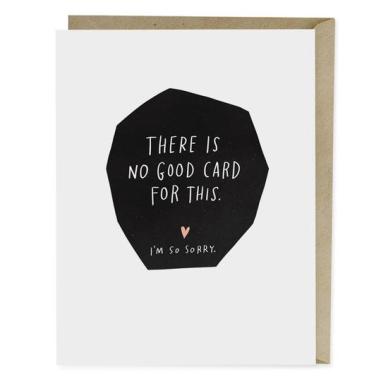Have you seen this quote from Brene Brown making the rounds on social media lately? As always, Brene speaks the truth.
As always, Brene speaks the truth.
As I’ve shared my challenges with friends, family members, and coworkers over the past several weeks, it’s been uncomfortable. No one likes to feel pain, and looking at others in pain can sometimes invite our own right in. Instead, we look away out of fear and discomfort. We resort to platitudes or silence. I understand that impulse. I’ve been there.
A few honest friends have confided in me that they’re worried about saying the wrong thing. I’ve been there, too. I’m positive that when I’ve spoken to people going through challenges I’ve never faced, I’ve said things that were not as helpful, comforting, or meaningful as I intended them to be. Call it “foot-in-mouth” disease or a manifestation of social anxiety – it can be hard to navigate what to say when the people we care about are suffering.
What I want to ask – even challenge you to do – is to do it anyway. When people are struggling and hurting, what gets them through is the feeling that they are not fighting alone.
In that spirit, I’d like to share with you some helpful guidelines on how to speak to someone who is facing cancer. Please note that all of these are guidelines and suggestions from my own experience. Someone else might require or ask something of you that’s not listed here. I also freely acknowledge that I may mess up, as will you. We are allowed. We’re both learning.
If you don’t know what to say, keep it simple: say exactly that.

“I don’t know what to say, but I am here to listen” is perhaps the most straightforward help you can offer. A cancer patient’s challenges are likely different than your own; news they are processing with might be overwhelming for you to consider. I’ve been told several times, “Wow, I don’t even know what to say.” I have always, always appreciated that simple honesty.
Google it.

I promise, I’m not trying to be smart-alecky. This is something I’ve done countless times when friends have faced miscarriages, child loss, loss of a spouse, or divorce… you name it. I was terrified of screwing it up, so I sought advice.
There are a lot of great resources out there on how to talk to and be supportive of someone with cancer. Here are a few I like:
How Can I Help? – Shameless self-plug. This is one of my old posts, so it’s already me-approved.
10 Tips for Supporting a Friend with Cancer – from Memorial Sloan Kettering.
Cancer Etiquette – from the Cancer Treatment Center of America.
5 Ways to Support a Friend with Cancer – From the Patient’s Playbook.
Try not to start any sentence with “at least.”

I will continue to share this video on empathy until everyone in America has seen it. If you have not seen it, stop what you’re doing and watch it now. I’ll still be here.
Saying “at least” is something we are all programmed to do. We like finding a silver lining or want to comfort a person we don’t want to see in pain. I am sure that I have said “at least” when talking to others about their own struggles; I am learning and actively working on correcting it myself.
Here’s why these words, while well-intentioned, can do a lot of damage: it is a daunting task for me to share candidly and allow myself to be vulnerable. When I do open myself up about my emotional messiness and others advise me to see the positive, it sends me into a shame spiral. I feel guilty that I can’t just be happy. I feel ill-equipped to handle my daily life. I shut down and feel like I shouldn’t have shared at all. This doesn’t help anyone and has the opposite of the intended effect.
As I wrote in a post back in March of 2018, “People say things which unintentionally minimize my struggle. ‘Look on the bright side!’ kind of comments or comparing suffering is not always helpful, even when well-intentioned. Yes, I sometimes make ‘it can always be worse’ comments because some days that’s where I am. But on the days when my fingers feel like they’ve been shut in a car door or I have no appetite and the thought of eating anything makes me sick, I’m not interested in the bright side.”
What can you do instead? Be vulnerable, too. Sit with the person in the discomfort and the pain without trying to mitigate it. You can’t change the challenges they’re facing, but you will certainly help them feel supported as they face them. When someone allows themselves to be present through the bad and the ugly, we all feel less alone.
Mirror the other person’s language.

If they say “I’m so disappointed,” you can respond “I’m so sorry you’re disappointed.” If that person says, “it’s so hard,” you can say, “that must be so challenging.” It sounds crazy, but it lets the person know you’re listening and their feelings are legitimate. Often times, patients aren’t seeking advice, they just need someone to listen. Everyone deserves to know that their feelings and experiences are valid. Mirroring their language is one way to let them know they are seen and you are there for them.
Send a card instead.

If you need some time to prepare what you want to say, send a card. Emily McDowell is a wonderful artist whose cards are honest and say exactly the kinds of things patients want to hear. They’re heartfelt and sometimes funny, such as:
“There is no good cards for this. I’m so sorry.”
“I’m really sorry I haven’t been in touch. I didn’t know what to say.”
“I’m so sorry you’re sick. I want you to know I will never try to sell you on some random treatment I read about on the internet.”
“I know there’s no normal to go back to. But I’m here to help you build a new one. (And I’ll bring snacks.)”
You can buy her cards or read her wonderful words here.
I’ve received so many beautiful cards and I’ve saved every single one: they are hanging in my kitchen on a clothesline since I have run out of space on my fridge. So many of the most impactful cards are those I’ve received on my hardest days – something the sender could have never anticipated. Needless to say, it’s a win-win.
A picture is worth a thousand words.

Is there an inside joke you can make time for? A distraction you can offer? Figure that out and offer it up often.
I have one friend who sends me photos of her dog whenever she thinks of it, another who sends me photos of her cat. Two other friends have appointed themselves Official Meme Senders and send me silly photos and videos on Instagram almost daily. They are a welcome distraction from my daily life of appointments and treatment prep.
Offer a specific way you would like to help.

Have leftover food from a party? Offer to bring it over in case your friend or a caregiver could use a meal. Do you work in the medical field? Maybe you can help navigate some of the research that’s related to their diagnosis. Have a stellar movie collection? Offer to drop some DVDs by for the person to enjoy. Strong personality? Make those calls to the insurance companies on someone’s behalf!
“Let me know if you need anything” is great, but when chemo brain sets in, I’m more likely to remember the specific tasks offered. I’ve had several friends offer to assist with specific tasks: coming over to keep me company, making vegetarian dinners, walking my dog on days I don’t feel up to it, researching what can help with chemo side effects. This is extraordinarily helpful, because if some day in the near future I think, “I really can’t walk my dog around the block today,” I know who I can call.
Do not expect a response and do not disappear.

I worry a lot – daily, if not hourly, that I am a burden on those I love and or that by sharing honestly what I am going through, I am driving away people that are close to me. Having spoken to others with cancer or chronic conditions, it’s a rather common and shared experience.
It means so much when people reach out without expectation or when silence is met with compassion. A few days ago, I did not have the energy to respond to anything or anyone. When I didn’t respond to the first text, a friend sent a message the following day saying, “No need to answer me. Just sending you love.” A few other friends, when I apologized for not getting back to them sooner, told me not to apologize. They just wanted me to know I was in their thoughts.
When all else fails, borrow one of these.

“I am so sorry you are going through this.”
“This sounds so hard. I am thinking of you.”
“I’ve been thinking about you a lot recently.”
“I love you.”
“You will not face this alone.”
“What do you need from me?”
Final Thoughts
A cancer battle is awkward and challenging – for everyone involved. I hope these suggestions help you feel better equipped to navigate tough conversations or discussions. At the end of the day, as long as you let the person know you love them, it will be enough.
Thank you to the many of you who are willing to be uncomfortable with me. I am humbled and grateful.

